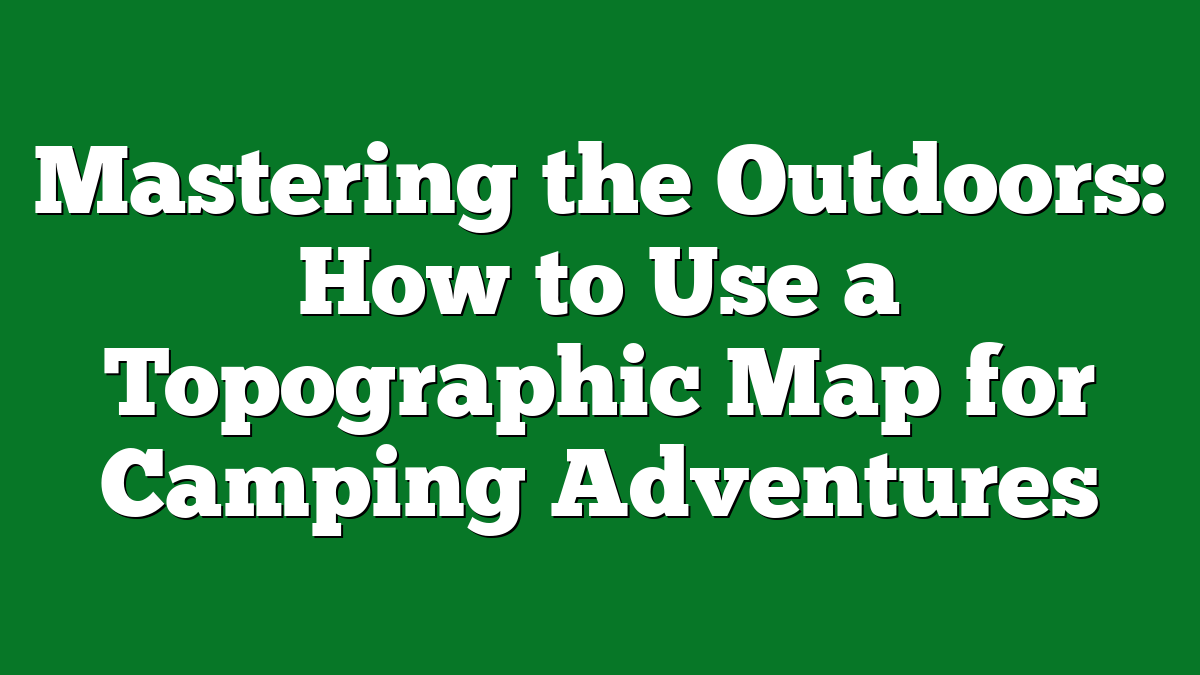When I first started camping, I quickly realized that a good map is just as essential as my tent and sleeping bag. Topographic maps are a game changer, offering a detailed view of the land’s contours, elevation changes, and natural features. Understanding how to read these maps can elevate your camping experience, helping you find the best spots and navigate the wilderness with confidence.
Understanding Topographic Maps
Topographic maps are essential tools for any camper aiming to explore the great outdoors. These maps provide crucial details about terrain and elevation, helping me select the best camping spots and navigate effectively.
What Is a Topographic Map?
A topographic map displays the Earth’s surface in three dimensions through contour lines. Each line represents a specific elevation, allowing me to visualize landforms like hills, valleys, and plains. The closer these lines are, the steeper the terrain. I often use these maps to identify potential obstacles and assess how challenging my hike could be.
Key Features of Topographic Maps
Topographic maps come loaded with features that enhance my camping experience. Here are some key components:
- Contour Lines: Indicate elevation changes; deciphering these helps me locate ridges and valleys.
- Scale: Provides a ratio that represents distance; it lets me plan my routes accurately.
- Symbols: Represent natural features like rivers, lakes, and forests; they give me insights into the environment.
- Color Coding: Differentiates between features such as water bodies and forested areas, aiding in planning my campsite.
- Grid System: Offers a coordinate system for precise navigation; I often cross-reference this with my GPS.
Using these features, I can better prepare for my adventures, making my camping trips safer and more enjoyable.
Benefits of Using Topographic Maps for Camping
Using topographic maps can enhance the overall camping experience significantly. These maps provide detailed information to ensure safety and enjoyment during outdoor adventures.
Enhanced Navigation Skills
Topographic maps improve navigation skills by allowing me to visualize the landscape effectively. I can determine my location based on contour lines and symbols, making it easier to follow trails or find water sources. The grid system also helps me pinpoint exact locations, ensuring I don’t stray off course. With practice, I become more confident in my navigation abilities, which is crucial for exploring unfamiliar areas. Utilizing these maps, I’ve been able to find the best routes while avoiding potential hazards.
Identifying Terrain and Elevation
Understanding terrain and elevation through topographic maps is invaluable for planning the perfect camping spot. The contour lines indicate how steep the areas are, letting me assess whether a trail is manageable or if I need to be prepared for a strenuous hike. Recognizing elevation changes helps me find ideal locations for setting up camp, such as flat, dry areas away from potential flooding zones. Moreover, I can discover scenic viewpoints that enhance my camping experience, offering breathtaking sights after a rewarding hike. Through this knowledge, I can tailor my trip to enjoy both comfort and adventure in the wild.
Steps to Using a Topographic Map for Camping
Using a topographic map transforms my camping experience. These maps reveal the land’s contours and natural features, guiding my adventure effectively.
Selecting the Right Map
Choosing a topographic map starts with identifying the area I plan to explore. I look for recent publications that reflect current trails and landmarks. I prefer maps that clearly display essential details, like elevation changes and natural features. It’s necessary to consider the scale; a larger scale offers more detail but covers a smaller area, while a smaller scale provides a broader view, perfect for long hikes. Utilizing online resources or visiting outdoor shops helps me find the right map for my trip.
Interpreting the Contours and Symbols
Recognizing contour lines and symbols is crucial for effective navigation. Each contour line shows elevation at specific intervals, allowing me to gauge the steepness of the terrain. A closer spacing of lines indicates a steep slope, while wider spacing suggests a gentler incline. Familiar symbols denote trails, water sources, and campsites, helping in quick identification during my hike. I carry a legend or key to ensure I understand all the symbols. Mastering this aspect helps me assess whether a route is suitable for my skill level.
Planning Your Camping Route
Planning my route involves mapping out trailheads, elevation changes, and potential campsites. I aim for a balance of challenge and enjoyment, ensuring I can reach my destination without overstretching myself. I utilize contour lines to select trails that lead to areas with natural resources, like water and flat ground for camping. I consider the expected weather conditions and sunlight exposure when determining my stops, ensuring I’ll have a safe spot to rest each night. By visualizing the terrain through the map, I enhance my chances of a rewarding camping experience.
Practical Tips for Using Topographic Maps
Using topographic maps effectively enhances my camping experience and ensures I navigate the wilderness confidently. Here are some practical tips that can make a difference on your outdoor adventures.
Combining with GPS and Other Tools
Combining topographic maps with GPS devices and smartphones amplifies navigation capabilities. I always carry a GPS for precise location tracking, while my map provides a comprehensive view of the terrain. In the backcountry, cellular signals can falter, so relying on both ensures I’m never lost. I mark waypoints on my GPS that correlate with map features, facilitating quick reference during my hikes. Battery life also matters; I keep a portable charger handy in case I need to rely on my device longer than expected.
Reading Maps in Different Conditions
Reading topographic maps in varying conditions presents challenges, but practice makes perfect. I’ve learned to rely more on visual cues and fewer on symbols or colors during heavy rain or fog. Weather affects visibility, so I take time to memorize key features such as peaks, valleys, and trails before setting out. On bright sunny days, glare on the map can obscure details, making a map case essential. I often fold my map to focus on specific sections to minimize confusion. By preparing for changing conditions, I stay oriented and confident no matter where my adventures take me.
Conclusion
Using a topographic map can truly transform your camping adventures. It’s not just about finding your way but also about discovering the beauty of the landscape around you. By understanding contour lines and symbols you’re equipped to navigate confidently and safely.
As I’ve learned through my own experiences the combination of a topographic map with modern technology can really enhance your outdoor journey. Whether you’re planning a challenging hike or a relaxing camping spot the insights you gain from these maps will make all the difference.
So next time you head out into the wild don’t forget to bring along a topographic map. It just might lead you to your next favorite camping location. Happy camping!











